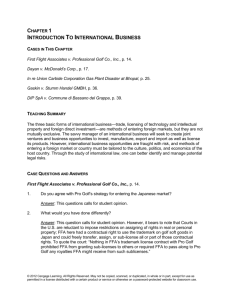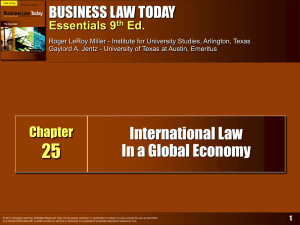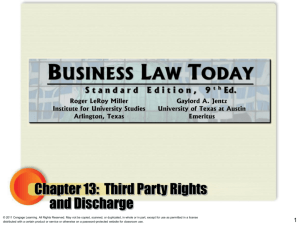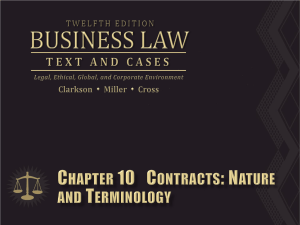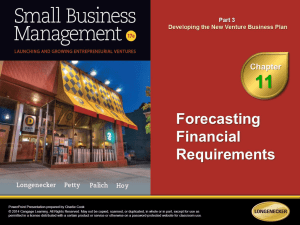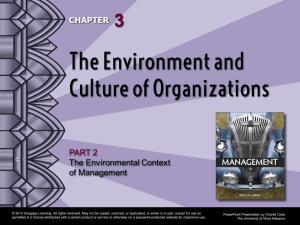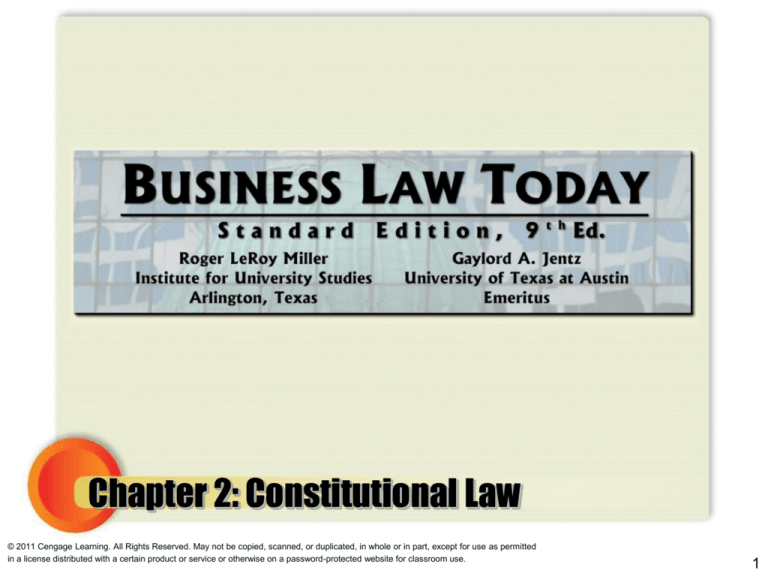
Chapter 2: Constitutional Law
© 2011 Cengage Learning. All Rights Reserved. May not be copied, scanned, or duplicated, in whole or in part, except for use as permitted
in a license distributed with a certain product or service or otherwise on a password-protected website for classroom use.
1
Learning Objectives
• What is the basic structure of the United
States government?
• What constitutional clause gives the federal
government the power to regulate commercial
activities among the various states?
• What constitutional clause allows laws
enacted by the federal government to take
priority over conflicting state laws?
• What is the Bill of Rights? What freedoms are
guaranteed by the First Amendment?
• Where in the Constitution can the due process
clause be found?
© 2011 Cengage Learning. All Rights Reserved. May not be copied, scanned, or duplicated, in whole or in part, except for use as permitted in
a license distributed with a certain product or service or otherwise on a password-protected website for classroom use.
2
Constitutional Powers of Government
• A Federal Form of Government: the federal
constitution was a political compromise
between advocates of state sovereignty and
central government.
• Separation of Powers: Executive,
Legislative and Judicial. Provides checks
and balances.
– Legislative: enacts laws
– Executive: enforces laws
– Judicial: declares laws/actions unconstitutional.
© 2011 Cengage Learning. All Rights Reserved. May not be copied, scanned, or duplicated, in whole or in part, except for use as permitted in
a license distributed with a certain product or service or otherwise on a password-protected website for classroom use.
3
The Commerce Clause
• U.S. Constitution gives Congress the
power to
– “regulate Commerce with foreign Nations,
and among the several States, and with
the Indian tribes.” (Art. 1 § 8)
• Greatest impact on business than any
other Constitutional provision.
© 2011 Cengage Learning. All Rights Reserved. May not be copied, scanned, or duplicated, in whole or in part, except for use as permitted in
a license distributed with a certain product or service or otherwise on a password-protected website for classroom use.
4
The Commerce Clause
• Gibbons v. Ogden (1824).
– To Chief Justice Marshall, commerce meant
all business dealings that substantially
affected more than one state.
– The national government had the exclusive
power to regulate interstate commerce.
• Today: commerce clause applies to ecommerce internet transactions.
© 2011 Cengage Learning. All Rights Reserved. May not be copied, scanned, or duplicated, in whole or in part, except for use as permitted in
a license distributed with a certain product or service or otherwise on a password-protected website for classroom use.
5
The Commerce Clause
• Expansion of Federal Regulatory
Powers under Commerce Clause:
– Wickard v. Filburn (1942). Purely local
production, sale and consumption of wheat
was subject to federal regulation.
Classic Case 2.1 Heart of Atlanta
Motel v. United States (1964).
Motel that provided public accommodations
to guests from other states was subject to
federal civil rights legislation.
© 2011 Cengage Learning. All Rights Reserved. May not be copied, scanned, or duplicated, in whole or in part, except for use as permitted in
a license distributed with a certain product or service or otherwise on a password-protected website for classroom use.
6
The Commerce Clause
• Commerce Power Today:
– Theoretically: the federal government has
unlimited control over all business
transactions since any enterprise (in the
aggregate) can have a “substantial effect”
on interstate commerce.
• 2005: State medical marijuana laws do not
insulate users from federal prosecution.
– Practical Limits: Supreme Court has curbed
federal regulatory powers in U.S. v. Lopez
(1995) and U.S. v. Morrison (2000).
© 2011 Cengage Learning. All Rights Reserved. May not be copied, scanned, or duplicated, in whole or in part, except for use as permitted in
a license distributed with a certain product or service or otherwise on a password-protected website for classroom use.
7
Regulatory Powers of the States
• Tenth Amendment reserves all powers
to the states that have not been
expressly delegated to the national
government.
• State have inherent “police powers.”
– Police powers include right to regulate
health, safety, morals and general welfare.
– Includes licensing, building codes, parking
regulations and zoning restrictions.
• “Dormant” Commerce Clause
© 2011 Cengage Learning. All Rights Reserved. May not be copied, scanned, or duplicated, in whole or in part, except for use as permitted in
a license distributed with a certain product or service or otherwise on a password-protected website for classroom use.
8
Dormant Commerce Clause
• U.S. Supreme Court has interpreted
commerce clause to give national
government exclusive power to
regulate.
• States only have a “dormant”
(negative) power to regulate interstate
commerce.
• Dormant power comes into play when
courts balance state’s interest vs.
national interest, e.g., internet
transactions.
© 2011 Cengage Learning. All Rights Reserved. May not be copied, scanned, or duplicated, in whole or in part, except for use as permitted in
a license distributed with a certain product or service or otherwise on a password-protected website for classroom use.
9
The Supremacy Clause
• Supremacy Clause: Article VI of the
Constitution provides that
Constitution, laws and treaties of the
United States are the “supreme law of
the land.”
• Concurrent: in few areas, both states
and federal government share powers.
• Preemption: when Congress chooses
to act in a concurrent area, federal law
preempts state law.
© 2011 Cengage Learning. All Rights Reserved. May not be copied, scanned, or duplicated, in whole or in part, except for use as permitted in
a license distributed with a certain product or service or otherwise on a password-protected website for classroom use.
10
Business and the Bill of Rights
• 1791: Ten written guarantees of
protection of individual liberties from
government interference.
• Originally, Bill of Rights only applied to
the federal government.
• Later, the Bill of Rights was
“incorporated” and applied to the
States as well.
• Some protections apply to businesses.
© 2011 Cengage Learning. All Rights Reserved. May not be copied, scanned, or duplicated, in whole or in part, except for use as permitted in
a license distributed with a certain product or service or otherwise on a password-protected website for classroom use.
11
First Amendment: Freedom of Speech
• Right to Free Speech is the basis for our
democratic government.
• Free speech also includes “symbolic”
speech, including gestures, movements,
articles of clothing.
– Texas v. Johnson (U.S. 1989).
– Hodgkins v. Peterson (7th Cir. 2004).
• Reasonable Restrictions: balance between
citizens’ right to speech, and government
protection of citizens.
– Morse v. Frederick (2007) “Bong Hits 4 Jesus” case.
© 2011 Cengage Learning. All Rights Reserved. May not be copied, scanned, or duplicated, in whole or in part, except for use as permitted in
a license distributed with a certain product or service or otherwise on a password-protected website for classroom use.
12
Commercial Speech
• Commercial speech (advertising) is given
substantial protection.
• Any government restrictions must:
– Seek to implement substantial government interest,
– Directly advance that interest, and
– Must go no further than necessary to accomplish.
Case 2.2 Bad Frog Brewery, Inc. v. New
York State Liquor Authority (1998).
NYSLA’s denial of BFB’s
application was an
unreasonable restriction on free
speech, and violated First
Amendment.
© 2011 Cengage Learning. All Rights Reserved. May not be copied, scanned, or duplicated, in whole or in part, except for use as permitted in
a license distributed with a certain product or service or otherwise on a password-protected website for classroom use.
13
Corporate Political Speech
• Corporate political speech continues to be
given significant protection under the First
Amendment.
• The Supreme Court has struck down recent
limits on corporate political in bi-partisan
campaign finance reform laws.
© 2011 Cengage Learning. All Rights Reserved. May not be copied, scanned, or duplicated, in whole or in part, except for use as permitted in
a license distributed with a certain product or service or otherwise on a password-protected website for classroom use.
14
Unprotected Speech
• U.S. Supreme Court has held that
certain speech is NOT protected:
– Defamatory speech.
– Threatening speech that violates criminal
laws.
– Fighting Words.
– Obscene Speech is patently offensive,
violates community standards and has no
literary, artistic, political or scientific merit.
© 2011 Cengage Learning. All Rights Reserved. May not be copied, scanned, or duplicated, in whole or in part, except for use as permitted in
a license distributed with a certain product or service or otherwise on a password-protected website for classroom use.
15
Online Obscenity
• Protected or Unprotected?
– Some of Congress’ attempts to protect
children from online pornography have been
ruled unconstitutional restriction on free
speech.
• Communications Decency Act (1996).
• COPA (1998-challenged, in court).
• Children’s Internet Protection Act (2000) which
requires filters for computers in public libraries
and public schools). Challenged, in court.
– What about “hate” speech on the web?
© 2011 Cengage Learning. All Rights Reserved. May not be copied, scanned, or duplicated, in whole or in part, except for use as permitted in
a license distributed with a certain product or service or otherwise on a password-protected website for classroom use.
16
First Amendment: Freedom of Religion
• First amendment guarantees that
“Congress shall make no law
respecting an establishment of religion,
or prohibiting the free exercise
thereof…”
• Establishment clause: no statesponsored religion or preference for
one religion over another.
© 2011 Cengage Learning. All Rights Reserved. May not be copied, scanned, or duplicated, in whole or in part, except for use as permitted in
a license distributed with a certain product or service or otherwise on a password-protected website for classroom use.
17
First Amendment: Freedom of Religion
Case 2.3 In re Episcopal Church cases
(2009).
California Supreme Court held that a
court can resolve a church property
dispute without “establishing” a church
in violation of the First Amendment.
• Free Exercise: person can believe what he
wants, but actions may be unconstitutional.
• What about freedom of religion and illegal
drug use?
© 2011 Cengage Learning. All Rights Reserved. May not be copied, scanned, or duplicated, in whole or in part, except for use as permitted in
a license distributed with a certain product or service or otherwise on a password-protected website for classroom use.
18
Due Process and Equal Protection
• Due Process is both procedural and
substantive.
– Procedural: any government decision to
take life, liberty or property must be fair.
Requires: Notice and Fair Hearing.
– Substantive: focuses on the content or the
legislation (the right itself).
• Fundamental Right: requires compelling state
interest.
• Non-Fundamental: rational relationship to state
interest.
© 2011 Cengage Learning. All Rights Reserved. May not be copied, scanned, or duplicated, in whole or in part, except for use as permitted in
a license distributed with a certain product or service or otherwise on a password-protected website for classroom use.
19
Equal Protection
• Government must treat similarly
situated individuals (or businesses) in
the same manner. Courts apply different
tests:
– Minimum scrutiny: economic rights.
– Intermediate scrutiny.
– Strict Scrutiny: fundamental rights.
• “Rational Basis” Test.
– In matters of economic and social welfare, a
classification will be considered valid if there is a
rational basis to some legitimate government interest.
© 2011 Cengage Learning. All Rights Reserved. May not be copied, scanned, or duplicated, in whole or in part, except for use as permitted in
a license distributed with a certain product or service or otherwise on a password-protected website for classroom use.
20
Privacy Rights
• Fourth amendment protects against
unreasonable search and seizures.
• Griswold v. Connecticut (1965) found a
right to personal privacy implied in
constitution, expanded in Roe v. Wade
(1973).
• Website privacy policies. What about
private information on the internet?
• USA PATRIOT ACT (2001).
• HIPAA (1996).
© 2011 Cengage Learning. All Rights Reserved. May not be copied, scanned, or duplicated, in whole or in part, except for use as permitted in
a license distributed with a certain product or service or otherwise on a password-protected website for classroom use.
21



